In 1986, the Loew’s Jersey theater played its last movie before closing — it was Friday the 13th. It was a brave choice of film because what the theater needed most, if it was going to remain standing, was a good omen.
The Jersey City theater was built in 1929, a decade that architect Charles Ward Rapp once called the “golden age for movie theater construction” in his biography. He, along with his brother George Rapp, designed the Baroque Revival theater to resemble a European palace — with a grand chandelier in the lobby and gilded and marble decor — that was every bit as fantastic as the movies on the screen.
“I don’t sell tickets to movies,” once said Marcus Loew, the owner of Loew’s theaters and the Metro Goldywn Mayer film studio. “I sell tickets to theaters.”
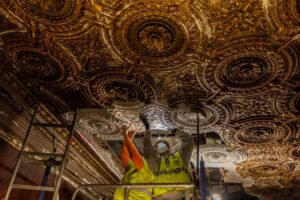
Workers repair the plaster ceilings inside the theater. Photo credit: The City of Jersey City
On the day it closed, the theater was beginning to age and the public’s appetite for entertainment was changing. In the 1970s, the management had even divided the 3,000-seat auditorium into a triplex in hopes of keeping it afloat. The same year, a developer called Hartz Mountain Industries bought the theater with the intent — or so they claimed — of restoring it, but soon after decided a restoration wasn’t feasible and planned to demolish it for office buildings.
“That building was a goner,” said Colin Egan, executive director of Friends of Loew’s, about the onetime prospects of preserving the theater. “It was a long battle to convince people to stop and look at what they had before it was demolished.”
But fortune was on Egan’s side. In 1987, the Planning Board voted on a redevelopment plan that effectively staved off demolition. It was a gutsy move as the board is filled with mayoral appointees and then-Mayor Anthony Cucci sided with the developer.
Not everyone was in favor of saving the Loew’s. Jersey Journal columnist Peter Weiss mocked the growing movement to save the theater, saying preservationists stood in the way of construction and office jobs and that the theater was neither historic nor worthy of protection. “It’s only 60 years old and pretty ugly on the outside,” he quipped.
The redevelopment plan to save the theater still needed to clear one more hurdle — the City Council. Not only did the legislation need enough votes to pass, but it needed six votes from the nine sitting council members to override Mayor Cucci’s veto.
In the end, the vote was 6-2 with one abstention, barely passing. “I was able to muster up six votes,” said Hudson County commissioner and current mayoral candidate, Bill O’Dea, who sat on the Planning Board and City Council at the time.
Egan doesn’t believe the Hartz would have ever built the office buildings — he believes that had they demolished the theater it would have become an empty lot. The property sits on a perilous crag that would have required a costly feat of engineering, he said.
In 1993, Hartz finally sold the theater to the city for a fraction of what they bought it for. By that time, Friends of Loew’s had become officially incorporated and its mission had shifted from merely appreciating the theater while it lasted to restoring the theater.
With a legion of volunteers, Friends of Loew’s began repairing the theater, removing the partitions that divided the auditorium, repairing the stage, repointing the facade, cleaning the grand chandelier in the lobby, and getting the projection booth up and running. The theater’s famous sculpture of a dragon battling St. George lights up again with a red bulb signifying fire.
“It was not a soup to nuts restoration — there wasn’t enough money for that,” Egan said. “Our goal was to get it functional.”
It wasn’t until 2021 that the theater got its long-awaited restoration. The $72 million project will take another year.
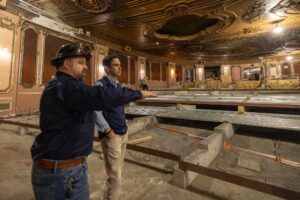
Peter Pietrucha from Phelps Construction Company talks to Mayor Steve Fulop inside the Loew’s Theater auditorium. Photo credit: The City of Jersey City
Standing on the stage and staring out into the auditorium, Doug Phelps, CEO of Phelps Construction, said that decades of smoke from cigars and coal furnaces had tarnished the gilded walls and light fixtures. When the work is completed, the theater will glisten like it did when the theater first opened in 1929.
“The grandeur and ornateness of this building is spectacular,” he said. “I think everybody will be surprised how this will look when it’s refurbished.”
One criticism that has plagued the ongoing restoration is that the theater, which was listed on the National Register in 2022, still hasn’t been designated a local landmark, which restricts the oversight of the local Historic Preservation Commission.
Mayor Steven Fulop, who stopped by the theater for the tour, said that before he leaves office he would designate the theater.
Paul Amatuzzo, a member of the Historic Preservation Commission, said this would be the best line of protection for the theater. But he wonders if there is enough time with only six months left in Fulop’s final term.
“Unless he decides it must happen immediately and puts all hands on deck to make it happen,” Amatuzzo said.
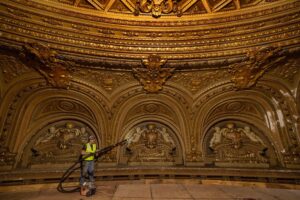
The dome inside the theater. Photo credit: The City of Jersey City.
Commissioner O’Dea, who is now vying for Fulop’s soon-to-be vacated post, said he would designate the theater a landmark if he becomes mayor in January.
It would be fitting if O’Dea won the mayoral race and cut the ribbon next year on the same theater he fought to save back in 1987, wouldn’t it?
“It’s been a little thought in my mind,” said O’Dea, who sits on the board of Friends of Loew’s. “Cutting the ribbon, after being the vote that saved it from the wrecking ball, that would be poetic justice.”
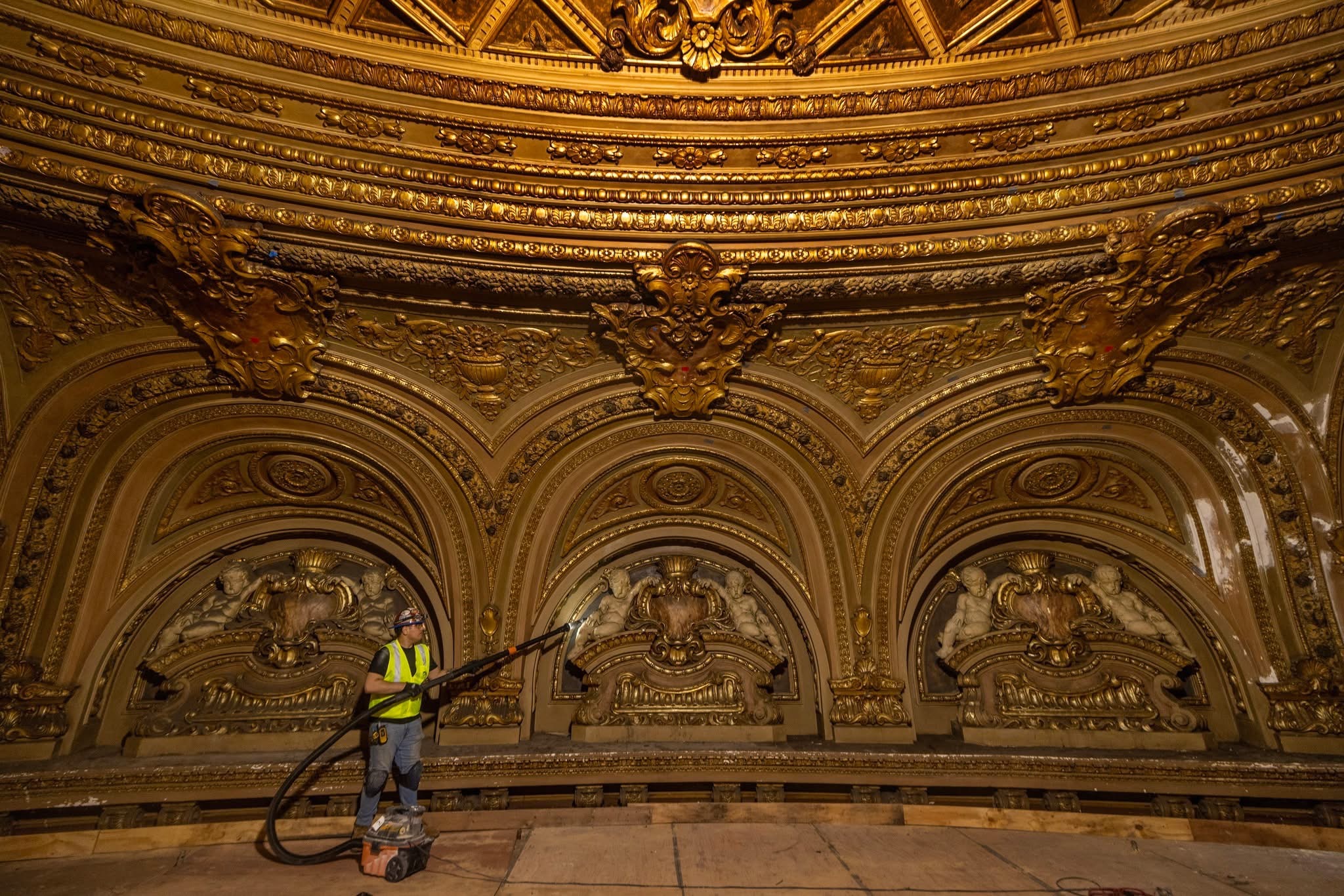



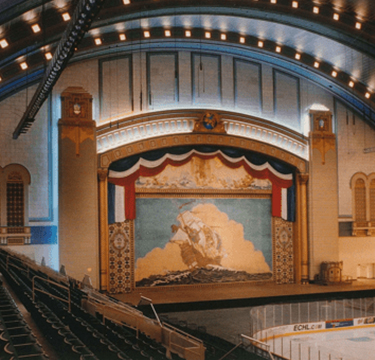
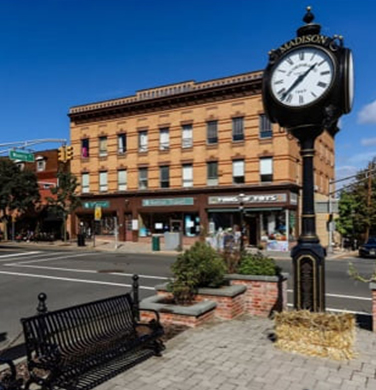

Chip renner
| 16 September 2025I had reached out to this group at least 2 times & have never heard back from them.